Hai Chau District, Da Nang City, Viet Nam
Business Registration Certificate: No. 0278, licensed by Vietnam Department of Transport
International Road Transport Licence: No. 110/2019, licensed by Vietnam Ministry of Transport
Japanese Covered bridge Hoi An is one of the must-see destinations when visiting Hoi An ancient town. Pagoda bridge is considered to be the soul, the symbol of Hoi An people with its relics and beautiful landscapes captivating people.
Where is Japanese Covered Bridge Hoi An?
Cau Pagoda across a small creek flows into the Thu Bon River with a length of about 18m, a width of about 3m. Japanese Covered Bridge is adjacent to Tran Phu and Nguyen Thi Minh Khai street, Quang Nam province.
Japanese Covered Bridge Hoi An Google Map:
Japanese Covered bridge Hoi An overview
Area and capacity of Hoi An Japanese Covered bridge
It has an area of about 60 m2 with a capacity of about 100 people on an excursion.
Historical value of Hoi An Japanese Covered bridge
It was built in the middle of the 17th century by Japanese merchants coming to trade in Hoi An. So, this bridge is also known as Japanese Bridge. In 1653, people built it additional pagodas, connected to the north railing, protruding the middle of the bridge. Since, people often called it with name “Cau Pagoda”. Despite through many stages of restoration, the pagoda bridge still retains its unique architectural features.
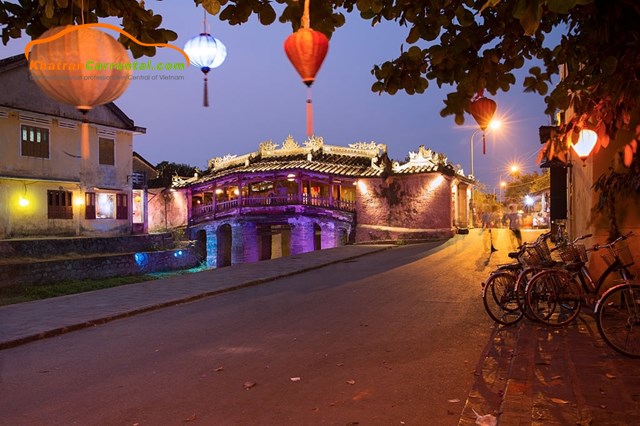
The legend of Cau Pagoda Hoi An in Quang Nam
Legend says that the cause of earthquakes for the community Vietnamese, Chinese, Japanese. There was one monster also known as Cu in Vietnamese, “Cau Long” in Chinese, Namazu in Japanese, its head is in Japan but its tail is in India, and its back is across Hoi An. So every time it moves, catastrophes like floods, earthquakes… will happen. To control this monster, Minh Huong people established a small temple regarded as a sword blocking the back of Namazu, preventing it from reviving, helping the people’s lives… all three countries are more peaceful.
What Gods are worshipped at Japanese Covered bridge Hoi An?
The special thing of the temple is that there no any Buddha statues inside Cau pagoda, we only see “Bac De Tran Vo” – a God protecting country, bringing joy and happiness for everyone. This shows that people want to express their desire, best wishes.
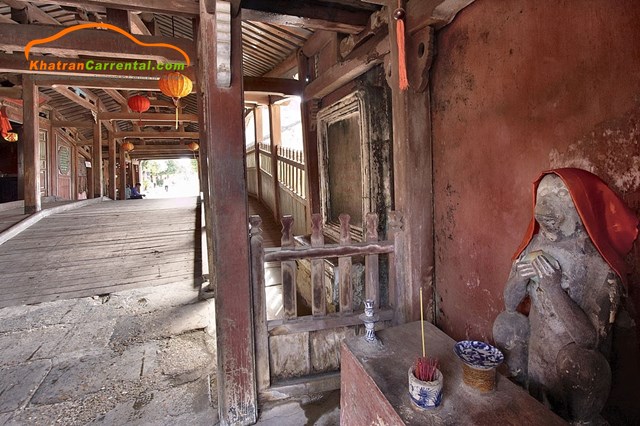
Hoi An Japanese covered bridge
Japanese Covered Bridge is considered to be a unique architecture because the temple roof is covered with yin and yang tiles to cover the whole bridge. On the main door, there is a large plate on which three Chinese “Lai Van Kieu” is carved.
Japanese Covered Bridge Vietnam is made of lacquered wood with finely carved line. It brings both Vietnamese architecture and a little style Japanese way. The two sides of the bridge have wooden statues of animals standing in flanking, one head is a dog statue, and the other is a monkey statue. These animals are worshipped popularly by Japanese people since ancient times. In the middle of, there is a place of worshiping North God, Tran Vo to pray for good things.
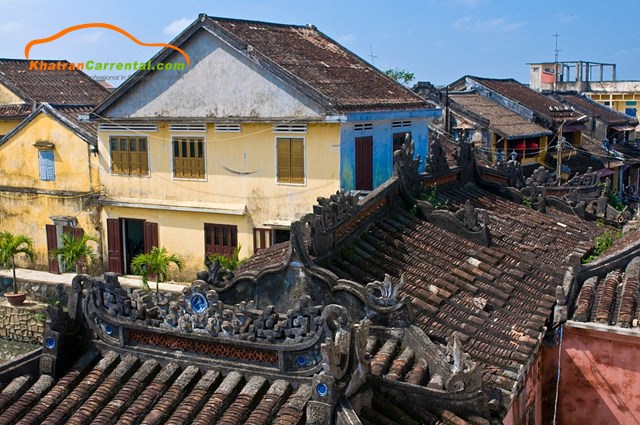
Seen from outer space, Japanese Covered bridge Hoi An has soft curved roof system supported by a wooden structure system, and the foundation is made with stone arches. The arched sphere is like a rainbow, two sides are two small wooden pedestal which formerly used as a trading place.
Lord Nguyen Phuc Chu visited Hoi An in 1917 and found it special, so he named Lai Vien.
Famous destinations near Japanese Covered bridge Hoi An
Hoi An Ancient Town
This is an ancient town located in the lower section of Thu Bon River, Minh Anh ward, Quang Nam province. Moreover, This old quarter consists of 1360 relics with old houses, tombs, shrines, deities, pagodas, bridges, etc. bearing unique architectural features. You can come here to go for a walk around the town or check in with the yellow wall, seamless colorful flowers.
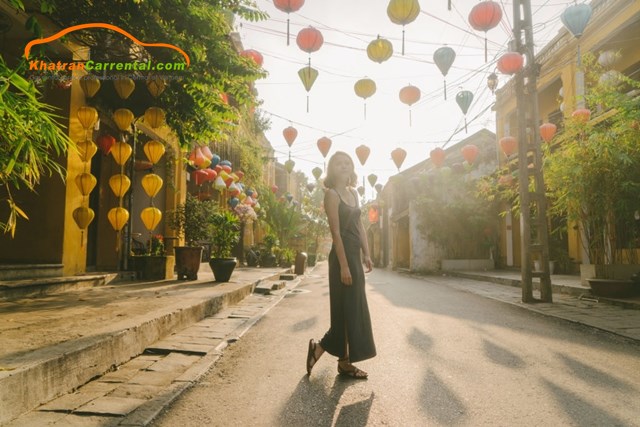
Cua Dai beach
Located about 5 km from Hoi An ancient town to the East. The sea stretches with white sand dunes, clear blue water. This has become a famous spot attracting domestic and foreign tourists.
An Bang Beach
Being in the top 25 most beautiful beaches in Asia in 2017 by visitors voted. It brings a peaceful beauty with fine white sand. Come here, you can rent canoes or water motorbikes, or play adventurous games like windsurfing, jumping…
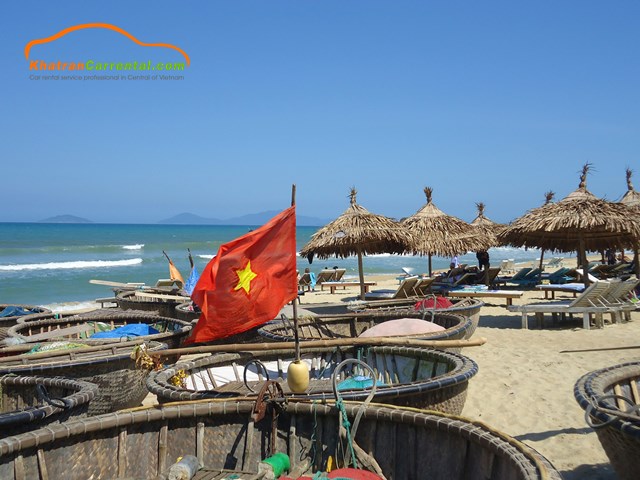
Thanh Ha Pottery Village
About 3 km to the West of Hoi An Japanese covered bridge, in Pham Phan, Quarter 5, Thanh Ha Ward, Hoi An City. Dropping by here,you will witness the beautiful ceramic products by skillful craftsmanship of artisans here. You can make handmade ceramic products and buy souvenirs for relatives and friends.
Bay Mau Coconut Forest in Hoi An
Located in hamlet 2, Cam Thanh commune, Hoi An city. You will be visit the Bay Mau forest completely on the basket boat and watch look at the tall green coconut groves, listen to Quang traditional folk music of local people. Ticket price is only 30.000 VND / people.
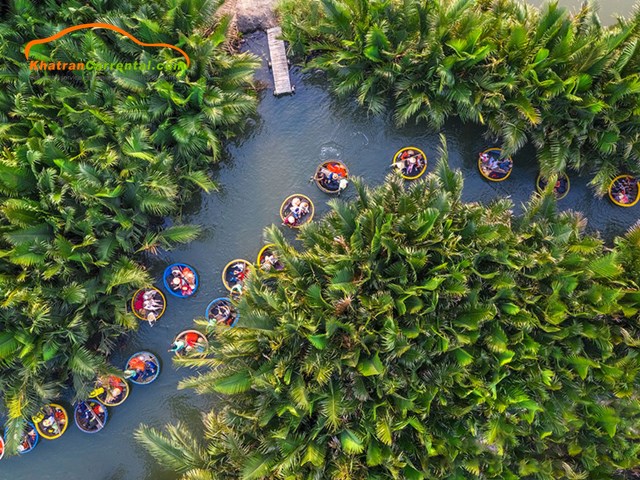
Hotels near Cau Pagoda Hoi An
– Square villa Hoi An: 23 Dao Duy Tu, Cam Pho, Hoi An
– Machi villa Hoi An: 38/27 Dao Duy Tu, Cam Pho, Hoi An
– Allegro Hoi An- Little Luxury Hotels & amp; Spa: 86 Tran Hung Dao, Ward Minh An, Hoi An
– Gem Riverside Hotel Hoi An: 14 Luong Nhu Bich, Cam Nam, Hoi An, Quang Nam, 0.9 km from Cau Pagoda.
– Cozy Savvy Boutique Hotel Hoi An: 116 Dao Duy Tu, Cam Pho Ward, Hoi An, Quang Nam.
Japanese Covered Bridge Hoi An is a must place to visit if you having chance to travelling there. Don’t forget to keep in notes with useful information we have just shared. We always accompanies you all the paths to discover the beauty of Hoi An ancient town and other places. So, what are you waiting for without calling us via Hotline: (+84) 91 651 0201 or (+84) 34 797 6789 to book car? Wish you have a meaningful trip to Hoi An!

